Evolution Technologies Airedale Heritage User manual
- Category
- Subwoofers
- Type
- User manual

Evo²–8
Evo²–10
Evo²–20
Evo²–30
Evo²–40
Evo²-50
Evo²–Centre
Evo²–DFS
Evolution²
USER MANUAL
Pacific Evo220066.qxd 18/10/2006 10:23 Page 1

22
User Warnings
Quick Start Guide
About Your Loudspeaker
Specifications
Quality Assurance
Accessories
CONTENTS
WITHIN THIS PACK
Evolution²
Pacific Evo220066.qxd 18/10/2006 10:23 Page 1

33 44
Please read the following notes carefully. They will help you to install your loudspeakers correctly and safely.
Switch off the amplifier and all sources before making connections to your sound system. When you switch on
the system or change sources, set the volume control to minimum and turn up the level gradually.
The position of your Volume Control is NOT a reliable guide as to the maximum capabilities of your system.
Playing the system with extreme settings of volume and tone controls may damage the amplifier and loudspeakers.
Do not connect loudspeaker terminals to the mains supply.
Ensure that your loudspeakers are correctly wired and are in phase.
Do not subject your loudspeakers to excessive cold, heat or sunlight.
WARNING: To reduce the risk of fire or electrical shock do not expose this product to rain or moisture.
The product must not be exposed to dripping and splashing and no object filled with liquids – such as a vase
of flowers – should be placed on the product.
No naked flame sources – such as candles – must be placed on the product.
Do not place heavy objects on top of loudspeaker cabinets. If you play them with the grilles removed be
careful to protect the drive units from children and pets.
Do not use makeshift stands. Always fit a manufacturer’ approved stand using the instructions and the
fixings provided. Your dealer will advise you.
Do not attempt to dismantle the loudspeaker. There are no user serviceable parts inside and you will
invalidate the warranty.
.
USER WARNINGS
QUICK SETUP GUIDE
(Evolution² Series)
Evolution² Evolution²
Pacific Evo220066.qxd 18/10/2006 10:23 Page 2

55 66
Evolution²
Always take care when lifting heavy objects.
Lift the speakers out by their sides.
If possible, keep the packaging in case you
need to move or return your speakers.
Carefully remove each loudspeaker from its packing
carton. Do NOT lift speakers via the polythene bag.
Be especially careful when removing large floor-
standing speakers.
The carton top says, “Open other end”. So you,
– Open the bottom
– Remove polystyrene
– Open bag containing speaker
– Tape the carton flaps back
– Turn over carton with loudspeaker still inside
– Lift carton off, leaving loudspeaker standing on the
floor. You may now remove the polythene bag.
Your speakers are heavy. Take care when
removing them from their packaging.
Setting Up the Evo² Series
Safely unpacking
Check you have
Loudspeaker preparation
Positioning stereo Hi-fi speakers
Connecting stereo Hi-fi speakers
Positioning AV speakers
Connecting AV speakers
Setting up AV systems
Looking after your loudspeakers
Evolution²
SAFELY UNPACKING
Pacific Evo220066.qxd 18/10/2006 10:23 Page 4

77 88
Evolution²
CHECK YOU HAVE
Evo²-8,10 Evo²-20,30,40,50 Evo²-DFS
User Pack
User Pack User Pack
Evolution²
FITTING SPIKES (EVO²-20,30,40)
Floor standing Evolution² speakers are sup-
plied with a set of floor spikes. Invert the
loudspeaker and place the top on a soft
surface. Screw the spikes into the bushes
fitted in the base of the cabinet. Carefully
return the loudspeaker to its normal posi-
tion. Adjust the height by screwing in or
out one or more of the spikes until the
loudspeaker is stable. For wood or soft
floors spike seats and self-adhesive pads
are provided.
WARNING: Floor standing speakers are
heavy - the spikes can penetrate softer
floors materials and damage wood and
stone floors over extended periods.
CONNECTIONS AND TERMINALS
Accessories:
• Spike set (4)
• Soft floor spike seats
Accessories:
• Rubber Spacers (4)
Choosing and Preparing Cables
Specialist audio cable usually offers better performance
than general purpose ‘bell’ or ‘zip’ wire.
Choose a cable of suitable diameter – cable that is too
thin will limit the dynamics of the sound and may impair
the bass response. Audio cable is polarised, with two
cores of different colours, or often a raised rib of
coloured tracer in the case of twin cable.
Split the twin cores to a depth of about 40mm. Carefully
strip the insulation from each end, leaving about 10mm
of bare wire. If the cable is stranded, lightly twist to
gather any loose strands.
Crossover Networks
Evo² front and centre loudspeakers use a specially
designed bi-wireable crossover panel with four terminal
binding posts. Please follow the drawing carefully to see
the correct orientation of the loudspeaker terminals. The
upper terminals connect to the treble unit and the lower
pair to the bass units. As supplied, the treble terminal
pair is connected to the bass terminal pair via removable
metal straps. These should be left in place for standard
single cable installations.
The Evo²-DFS speaker uses a twin terminal panel.
Connecting Loudspeaker Terminals
Unscrew the terminal. Thread the bared end of each
cable through the hole in the bottom of the terminal
post. Ensure that there are no loose strands which may
touch adjacent terminals. Retighten the terminal secure-
ly.
NOTE: When connecting loudspeakers, the cables to left
and right channels should be of equal length, regardless
of the distance of the speakers from the amplifier. In
Home Cinema systems, this applies to front and rear
channels.
40mm
10mm
LOUDSPEAKER PREPARATION
Evo²-Centre
User Pack
Accessories:
• Rubber Feet (4)
Pacific Evo220066.qxd 18/10/2006 10:23 Page 6

1100
Evolution²
99
CONNECTING HIFI SPEAKERS
POSITIONING FRONT SPEAKERS
Single wired a single amplifier, link bars are fitted
Bi-wired – a single amplifier, with separate wires
to drive the bass/mid unit and the treble unit.
Note that the wiring link bars are removed.
Bi-amplified – two amplifiers.
One drives each section.
Note that the wiring link bars are removed.
Important Note, please make sure that heavy multi-standard
cables are well connected and clamped. Single loose strands
arcing can cause a noise in the woofers like a faulty speaker.
Evolution²
Angle speakers inward by 5º to 30º
for a clearer, more tuneful mid range.
If the loudspeakers are placed too close to the walls the bass will increase but may
be boomy and indistinct. If the loudspeakers are placed further away from the
walls, the inward angle may be increased by upto 40%, although this may restrict
the width of the optimum listening position. As personal taste plays a large role,
experiment with different configurations and play a wide range of programme
before finalising the position of your speakers.
Using sseparate ccables ffor
treble aand bbass uunits iin aa
Bi-wwiring cconfiguration
reduces iintermodulation
e
ffects aand iimproves
headroom aand cclarity. TTo
Bi-wwire, yyou wwill nneed tto
install ttwo llengths oof ttwin
core
ccable bbetween tthe
amplifier aand eeach lloud-
speaker.
Unscrew eeach tterminal aa
few tturns aand rremove tthe
meta
l sstraps.
Connect tthe ccables bbetween
the aamplifier aand tthe lloud-
speakers aas iindicated aand
re-ttighten aal
l tthe tterminals
securely.
Note: SSome aamplifiers hhave
two ppairs oof ooutput tterminals
to ffacilitate bbi-wwirin
g bbut tthis
is nnot eessential. TThe aadvan-
tages oof bbi-wwiring aare ffully
retained iif yyour aamplifier hhas
only o
one ppair oof ooutput tter-
minals pper cchannel ((as iin
the iillustration).
Positioning the speakers. Place the speak-
ers so that you are the same distance from
each. The distance between the speakers
should be the same as between you and
the speakers.
For best results the speakers should be at
least 10 inches (20cm) in front of a wall
and at least 30 inches (70cm) from any
corner.
RIGHT
SPEAKER
LEFT
SPEAKER
RIGHT
SPEAKER
LEFT
SPEAKER
70cm
20cm
Amplifier
Amplifier
Pacific Evo220066.qxd 18/10/2006 10:23 Page 8

1111 1122
Evolution² Evolution²
POSITIONING AV SPEAKERS
THE HOME THEATRE ENVIRONMENT
Front and Effects Channels
The front loudspeakers are placed on either side of the television screen, 2 to 3 metres
apart. The speakers should be angled slightly so they are aimed towards the listeners.
As the rear surround channels are the ‘effects’ channels the reproduced sound should be as
room filling as possible. We recommend placing the speakers in a high position, behind the
listeners head. If the rear wall is more than 1 metre behind the listening seat, position the
units on the side walls. If the walls are a long way from the listening seat, consider stand
mounting the loudspeakers.
Most of the dialogue comes from the centre loudspeaker. Speech should appear to originate
from the actors mouths. Operating height is important. Ideally the front and centre channel
speakers should be at the same height. For this reason the centre channel speaker is best
operated above the television monitor.
Subwoofer
As the ear is unable to detect the direction from which deep bass origi-
nates, this allows you freedom to position a subwoofer according to the
level of bass required. Placing the subwoofer near a corner or particu-
larly close to a wall will boost the bass but may impair clarity.
The performance of Home Theatre systems can often be enhanced by
using a pair of subwoofers.
Evo²-DFS Surround Loudspeaker
As the rear effects channels are restricted in both frequency and dynamic range, there
is no particular advantage to be gained from bi-wiring. The DFS loudspeaker has a
single set of connection terminals as shown in the diagram.
Four self adhesive spacers are provided with each unit. Attach one close to each rear
corner of the cabinet. This speaker is designed primarily for wall mounting – please
see separate section for this topic.
Evo²-Centre Loudspeaker
A set of self adhesive pads is provided. Peel off the backing material and fix a
pad close to each corner of the bottom surface of the loudspeaker.
The Evo²-Centre Loudspeaker
The loudspeaker should be positioned centrally between the loudspeakers close to the televi-
sion and mounted either above or below the screen.
The loudspeaker should be located on a stable flat surface to avoid any danger of the cabinet
moving when it is vibrated by high sound levels. If you mount the unit on top of the televi-
sion, move it forward so that the front grilles are level with or slightly in front of the screen.
This will reduce reflections from the screen and the top of the cabinet.
Although you can place the centre channel loudspeaker under the TV monitor, this should be
regarded as a second best. The preferred position is always above the monitor.
The Evo²-DFS Loudspeaker
Connect the cable to the speaker. The speaker should ideally be sited 600mm – 1.5 metres
above the listening position and 2.5 - 3.5 metres apart, central to the listener and behind
the listening position, preferably on a rear wall. If the listening position is some distance from
a rear wall, the loudspeakers may be mounted on opposite side walls but always behind the
listening position.
Ensure that the wall is strong and can support the product. Drill two 5mm holes in the wall
160mm apart and horizontally aligned. Fix a suitable No 8 round head screw firmly into
each hole using appropriate wall plugs. Leave a stub of 5mm protruding from the wall. Align
the holes in the mounting brackets over the screw heads and carefully lower the unit onto
the screws. The speaker can now be securely attached with the spacers resting against the
wall. Now connect the speakers to the amplifier before final mounting of the surrounds.
POSITIONING & CONNECTING AV SPEAKERS
System with Rear Mounted Evo²-DFS
System with Side Mounted Evo²-DFS
System with Subwoofer Speakers
FRONT RIGHT
SPEAKER
REAR RIGHT
SPEAKER
REAR LEFT
SPEAKER
FRONT LEFT
SPEAKER
CENTRE
SPEAKER
Pacific Evo220066.qxd 18/10/2006 10:23 Page 10

Evolution² Evolution²
1133 1144
Setting Loudspeaker Sizes
Many digital AV Processors require you to specify the size of speakers in all channels.
These are usually ‘Large or small’. Always set the Evo²-DFS and the Evo²-Centre to
‘small’.
IF YYOU AARE UUSING AA SSUBWOOFER
For tthe EEVO²-88 aand 110 wwhen uused aas FFront SSpeakers:
Set these to ‘small’. The sub-
woofer will now receive all the system bass signals.
For tthe EEVO²-330, 44
0 aand 550:
Set these to ‘large’. The subwoofer then will reproduce
only the LFE and bass signals from the effects channels.
The EEvo²-220
may be set to either ‘large’ or small depending on personel preference and
the capacity of the subwoofer.
If yyou aare nnot uusing aa ssubwoofer:
Set the front speakers to ‘large’. Set the subwoofer
option on the processor to ‘Off’ or ‘No’. The front channels will now receive all the
system bass.
Setting Levels
Once the loudspeaker settings have been finalised, put the AV amplifier into its “test”
mode (see instructions supplied with your processor). Adjust the level of each channel
in turn until all channels are reproduced at equal loudness.
On some programme material the surround channel may seem lower than the front. Do
not readjust this level. You may, however, need to adjust the subwoofer output level.
Avoid setting too high a level or you will swamp the sound with bass. This can be tiring
to listen to, and may limit the subwoofer’s ability to respond to large bass transients.
You should also set a sensible level going into the subwoofer from the AV processor.
Delay Settings
Many AV processors feature delay settings. The purpose of delay is to enable surround
and dialogue information to arrive at the listener’s ears at the same time as the front
channels, even when the listening seat is in a non-ideal position. On some processors,
this can be achieved by setting the distance from the listening position to each speaker
in turn, but other systems allow only a time delay setting.
Rear DDelay
: If the listening position is equidistant from the front and rear speakers, a
low delay setting should be set. The closer the listener is to the rear speakers the high-
er the delay setting used should be.
Centre DDelay
: If the centre speaker is level with (or slightly behind) the front speakers, set
the delay to zero. If the centre speaker is forward of the front speakers, increase the delay.
LFE
In the cinema the low frequency effects channel is an extra bass channel with its own
subwoofer and not a regular subwoofer channel. In domestic systems the LFE channel
typically feeds into the subwoofer. Where no subwoofer is used, the LFE signal is com-
bined with front channel information and sent to the front speakers. When you set the
LFE level at your AV processor, use care as the powerful low frequencies can overload
domestic loudspeakers.
If you hear popping or thumping noises coming from the front loudspeakers or sub-
woofer, immediately turn the AV Processor’s volume level down and then lower the LFE
level. This should cure the problem. If it does not, lower the volume level at the sub-
woofer (if you are using one) until the problem disappears.
Please read the relevant sections of your AV amplifier manual and familiarise yourself
with the various issues. If you are unsure, consult your dealer for help.
Phase
A home theatre system should have a precise front stage, a diffuse rear stage and good
localisation of dialogue. If the colours on the loudspeaker terminals do not correspond
with those on the amplifier, the sound will appear poorly focussed or ‘Out of phase’. For
this reason it is essential that the speakers are connected accordingly to the wiring dia-
grams in this manual.
SETTING UP AV SYSTEMS
SETTING UP AV SYSTEMS
Pacific Evo220066.qxd 18/10/2006 10:23 Page 12

1155 1166
For technical support, servicing or product queries and information please
contact either your local retailer or the offices below.
TECHNICAL SUPPORT AND INFORMATION
UK
IAG Service Centre
Unit 4, St Margaret’s Way
Stukeley Meadows Industrial
Estate
Huntingdon, Cambs,
PE29 6EB
England
Tel:+44 (0)1480 452561
Fax: +44 (0)1480 13403
www.wharfedale.co.uk
USA
IAG America, Inc.
8440 154th Avenue NE
Redmond,
Washington 98052
USA
Tel: +1 425 861 3909
Fax: +1 425 861 3906
ASIA
Room 2310 - 2311 Press
Building,
Shennan Road C,
Shenzhen,
China
Tel: +86-755-82091200
Fax: +86-755-82091205
Evolution² Evolution²
Do not open the speakers; there are no
user serviceable parts inside.
Avoid getting any liquid behind the grille.
LOOKING AFTER YOUR LOUDSPEAKER
Remove marks from the cabinet and
polish it with a soft, slightly damp cloth.
Pacific Evo220066.qxd 18/10/2006 10:23 Page 14

Evolution² Evolution²
1177 1188
ABOUT YOUR LOUDSPEAKER
The Evolution² series is a range of versatile loudspeakers equally outstanding in
both Audio-Visual and 2-Channel applications. When used in Home Cinema
systems with the designed DFS surround loudspeaker and the SW range of sub-
woofers, they offer a performance unsurpassed in their class.
These loudspeakers exhibit exceptional performance characteristics based upon
the following concepts.
Very low distortion across the entire audio band.
Low excursion requirement of the cone drivers.
High flux magnet systems enabling good dynamic response and impulse
control.
Broadband dispersion for excellent stereo image and staging.
Careful attention to component design, operation, integration and acoustics.
THE CABINET
The enclosure of your speaker is finished to a high-quality furniture standard.
Real wood veneers are selected and carefully pattern matched by hand. Over a
period of several days a high quality hard lacquer finish is achieved. This
involves the application of several coatings of lacquers, each being cut and pol-
ished before the next coat is applied. Only through this time-consuming and
skilled technique, can we achieve the deep and lustrous finish that is the char-
acteristic hallmark of Wharfedale premium loudspeakers.
Instead of the usual cuboid shape , Evo² loudspeaker cabinets feature a beauti-
ful curvaceous design, with a special purpose; - to reduce to negligible levels
internal cabinet standing waves and reflections. Skilful engineering in ‘MDF’
(Medium Density Fibre Board), universally known to be one of the best enclo-
sure materials, has resulted in an ideally shaped, very strong, internally multiple
braced, low resonance structure.
Parallel-sided tall boxes promote the creation of unwanted acoustic waveforms
within the box by reflection up and down its length; these both add and sub-
tract at different frequencies, creating anomalies in the forward response. The
multiple curved and braced interior of the Evo² cabinet prevents this - the result
is a soundstage of unexampled clarity and precision with pinpoint imaging, even
frequency distribution and inherently low coloration.
‘THE EVOLUTION² SERIES
Pacific Evo220066.qxd 18/10/2006 10:23 Page 16

Evolution²
2200
Evolution²
1199
THE DRIVE UNITS
THE BASS DRIVERS
The bass driver(s) incorporates a new design of cone utilising our own Kevlar bi-weave
process. Kevlar has immense longitudinal strength and is used in many structures
where high strength and light weight are key attributes. Kevlar can be found liberally
used in Formula 1 racing cars, aeroplanes, boats, spacecraft, skis and even golf clubs.
These fibre bundles are woven and impregnated with special bonding resins that are
subsequently pressure formed and heat cured. The resulting material is stiff, rigid and
exhibits very low levels of internal resonance. Consequently, energy losses in the cone
transfer mechanism are very low.
Similarly, lateral voice coil strength is very high. We use a combination of half hard
aluminium and resin bonded glass fibre. This, in turn, contributes towards some of the
lowest distortion figures ever seen in conventional drivers. The dust cap/cover is of the
same material as the cone.
The bass drivers operate only over the low frequency range. They are only used over
their true pistonic range. The cone is terminated with a conventional large half roll of
synthetic butyl rubber with excellent inherent damping qualities.
A high performance traditional ferrite magnet system is used. Motional noise can be a
problem with high output bass systems. We address this by moving air through vents
in the voice coil. The magnet system is also fully vented throughout.
THE BASS MIDRANGE DRIVERS (Evo² 30,40,50)
In any system featuring a cone bass/mid driver, performance and dispersion in the
upper midrange band is critical, and even more so when (as in our Evo² 30 and 40
models) the midrange driver is crossing over to a dome tweeter,even one with as wide
and well maintained a response as our Evo² dome tweeters.
By using a very low mass ultra stiff Kevlar cone in our bass/midrange drivers we pro-
vide virtually loss-less energy transfer from the coil ensuring good impulse and dynam-
ic response times. This, combined with a carefully developed cone profile and a pre-
cisely shaped central coil cap projection, allows the higher bass and midrange fre-
quencies to provide not just extension but also wide dispersion at the bass unit's upper
crossover point. The result is a seamless crossover transition to the tweeter without the
compromised off-axis performance usually associated with most 2 way designs.
THE 5Omm SOFT DOME MIDRANGE (Evo²-50)
Derived from our flagship ‘Airedale Heritage’ loudspeaker, we have designed a series of dome mid-range
units which are exclusively used in our high-end loudspeaker products. Although costly to produce, the
benefits of a using a dome mid-range – particularly one with such as wide bandwidth as our own – are
lower distortion through this region, better integration throughout the frequency spectrum and an
extremely wide dispersion - all contributing to a very relaxed, natural presentation.
Because each driver in a multi-way system covers a smaller bandwidth, dynamic range and transient
response are hugely improved. Often this is at the cost of frequency integration but when our unique
dome technology is deployed, integration between upper and lower drive units is virtually seamless.
THE 25mm 1” SOFT DOME TWEETER
The highest frequencies are handled by a soft dome driver. Our extensive research has proven these are
a better choice than the metallic based domes that typically add their own character to the treble.
A feature of the tweeters, as with the mids, is wide dispersion and very low distortion, again typically
less than 1% at 100dB at 1 metre. The unit features a high flux neodymium magnet structure,
producing a typical efficiency of 93dB 1W@1m. This unit has a frequency response extending far
beyond audible frequencies to around 45kHz.
THE CROSSOVER AND WIRING
High quality OFC cable is used in each loudspeaker for internal wiring. High quality resin fibreglass
printed circuit boards are used throughout, and all connections are made to audiophile standards.
All inductors used are perfect layering wound and bonded and use large gauge wire for very low
insertion loss.
All capacitors used are either, low loss, low ERC polypropylene or high quality audio grade reversible
electrolytics.
Pacific Evo220066.qxd 18/10/2006 10:23 Page 18

2 Way
5” 125mm
1” 25mm
6 Ohms
4.0 - 17.0
65Hz-28kHz
45Hz
32kHz
87dB
<7%
<1%
75 Watts
30–150W
107dB
90 to 12kHz
70 to 12kHz
ported
10 litres
50Hz
2.0kHz
15 & 25mm MDF
Satin Lacquer finished real wood veneers of Light Maple, Rosewood, Cherry, Black Ash
13118
0367
330 x 185 x 336
7.0kg x 2
440 x 485 x 375
15.5kg
Evolution²
2222
Evolution²
2211
SPECIFICATIONS
Transducer Complement
Cone Bass driver
Cone Bass/Mid Driver
Soft Dome Tweeter
Nominal impedance
Impedance variation (Ohms)
Frequency response +/- 3dB
Low frequency limit -10dB
Upper frequency limit -10dB
SPL 1W @ 1m
Typical Distortion - to 300Hz
(100dB@1m) - over 300Hz
Continuous Programme Power
Recommended Amplifier Power
Max Peak SPL
Nominal coverage horizontal
Nominal coverage vertical
Enclosure type bass/mid
Volumes bass/mid
System Fb
Crossover frequencies
Construction material
Finish
Component part numbers
Bass driver
Bass/Mid Driver
Dome Midrange Driver
Tweeter
Product dimensions H x W x D
Net weight
Carton dimensions H x W x D
Gross weight
2 Way
5” 125mm x 2
1” 25mm
6 Ohms
8.0-22.0
90Hz-35kHz
60Hz
43kHz
89dB
20–200Hz <4%
above 200Hz <1%
100 Watts
30–200W
111dB
90 to 12kHz
70 to 12kHz
sealed
12 litres
90Hz
2.4kHz
15 & 25mm MDF
13119
0372
185 x 420 x 300
8.95kg
530 x 340 x 245
10.0kg
Evo²-8 Evo²-20 Evo²-40 Evo²-50
2 Way
5” 125mm x 2
1” 25mm x 2
6 Ohms
5.0-12.0
60Hz-32kHz
55Hz
32kHz
88dB
20–200Hz <4%
above 200Hz <2%
100 Watts
30–200W
108dB
180 to 10kHz
70 to 12kHz
ported
8 litres
70Hz
3.kHz
15mm MDF/Plate
13119
0373
362 x 350 x 162
4.7kg x 2
428 x 425 x 400
11.5kg
EVO²-DFS
2 Way
6.5” 175mm
1” 25mm
6 Ohms
4.0–16.0
57Hz-28kHz
40Hz
32kHz
88dB
<7%
<1%
100 Watts
30–200W
109dB
90 to 12kHz
70 to 12kHz
ported
15.3 litres
50Hz
2.2kHz
15 & 25mm MDF
17167
0371
380 x 227 x 356
8.1kg x2
490 x 575 x 395
18.5kg
3 Way
6.5” 170mm
6.5” 170mm
2” 50mm
1” 25mm
6 Ohms
4.0-27.0
30Hz-28kHz
27Hz
32kHz
90dB
<5%
<1%
150 Watts
50–300W
113dB
90 to 15kHz
70 to 15kHz
ported / sealed
33 / 13 litres
30Hz
150Hz,1.3kHz,6.5kHz
15 & 25mm MDF
17169
17168
07104A
0371
1160 x 229 x 400
25.6kg
1270 x 600 x 460
58.0kg
Evo²-10
Evo²-Centre
2 Way
6.5” 170mm
1” 25mm
6 Ohms
4.0–16.0
50Hz–28kHz
35Hz
32kHz
88dB
<7%
<1%
100 Watts
40–200W
109dB
90 to 12kHz
70 to 12kHz
ported
23.8 litres
40Hz
2.2kHz
15 & 25mm MDF
17167
0371
890 x 227 x 356
15.5kg x 2
1020 x 600 x 410
34.5kg
2.5 Way
6.5” 170mm
6.5” 170mm
1” 25mm
6 Ohms
4.0–17.0
35Hz-28kHz
35Hz
32kHz
89dB
<5%
<1%
125 Watts
50–250W
111dB
90 to 12kHz
70 to 12kHz
ported / sealed
28 / 15 litres
35Hz
150Hz,2.2kHz
15 & 25mm MDF
17169
17168
0371
920 x 229 x 400
20.8kg
1060 x 600 x 460
46.0kg
2.5 Way
6.5” 170mm
6.5” 170mm
1” 25mm
6 Ohms
4.0-16.0
30Hz-28kHz
30Hz
32kHz
89dB
<5%
<1%
150 Watts
50–300W
112dB
90 to 12kHz
70 to 12kHz
ported / sealed
37 / 15 litres
35Hz
150Hz,2.2kHz
15 & 25mm MDF
17169
17168
0371
1110 x 229 x 400
24.0kg
1250 x 600 x 460
54.0kg
Evo²-30
Pacific Evo220066.qxd 18/10/2006 10:23 Page 20

Crossover sections
Type
Wiring
Connections
2 way, 2.5 way, 3 way
Butterworth
HQ OFC cable
solder
CROSSOVER SPECIFICATIONS
Part number
Dome material & size
Coil size & type
Magnet d1 x h
Magnet weight
SPL 1w @ 1m
Fs
Frequency range -3dB
Upper frequency limit -10dB
Distortion at 100dB @ 1m
0367
25mm textile
25mm aluminium
25.4 x 4mm Neodynium
14gm
93dB
1.3kHz
800Hz–40kHz
45kHz
typically < 1%
TWEETER SPECIFICATIONS
Evolution²
2244
Evolution²
2233
Frame material
Cone & dome material
Surround
Spiders
Coil size & type
Winding spec
Magnet (D1 x D2 x H)
Magnet weight
Gap flux density
Top plate thickness
Optimum working range
Venting
Thiele SSmall pparameters
Effective cone diameter
Re
Fs
Qms
Qes
Qts
Mms
Cms
Vas
BL
Aluminium
Woven Kevlar
s r b p Single roll
Single
25mm Aluminium
4 layer round cu x 11.5mm
70 x 32 x 15 ferrite
106gm
0.9 T
6mm
40Hz – 500Hz
Coil, pole
4 – ö4
140mm
5.8Ù
40Hz
7.13
0.69
0.63
28.11gm
0.54mm/N
17.76L
7.78t/m
170mm (6.5”) Bass 170mm (6.5”) Bass/Mid 170mm (6.5”) Bass/Mid
Aluminium
Woven Kevlar
s r b p Single roll
Single
25mm Aluminium
2 layer round cu x 11.2mm
70 x 32 x 15 ferrite
106gm
1.0 T
6mm
54Hz–4000Hz
Coil, pole
4 – ö4
140mm
5.8Ù
54Hz
4.67
0.84
0.71
16.62gm
0.51mm/N
16.77L
6.3t/m
Aluminium
Woven Kevlar
s r b p Single roll
Single
25mm Aluminium
2 layer round cu x 11.5mm
80 x 32 x 15 ferrite
168gm
1.0 T
6mm
58Hz–5000Hz
Coil, pole
4 –
ö4
105mm
3.4Ù
58Hz
3.14
0.37
0.33
8.01gm
0.93mm/N
9.69L
5.22t/m
Aluminium
Woven Kevlar
s r b p Single roll
Single
25mm Aluminium
2 layer round cu x 13.6mm
80 x 32 x 15 ferrite
168gm
1.0 T
6mm
65Hz–5000Hz
Coil, pole
4 – ö4
105mm
14.5Ù
65Hz
3.32
0.68
0.56
7.26gm
0.83mm/N
8.64L
7.95t/m
Aluminium
Woven Kevlar
s r b p Single roll
Single
25mm Aluminium
2 layer round cu x 15mm
70 x 32 x 15 ferrite
106gm
1.0 T
6mm
54Hz–4000Hz
Coil, pole
4 –
ö4
140mm
3.4Ù
54Hz
4.75
0.66
0.58
17.17gm
0.51mm/N
16.94L
5.48t/m
Part number
Dome material & size
Coil size & type
Magnet d1 x d2 x h
Magnet weight
SPL 1w @ 1m
Fs
Frequency range -3dB
Upper frequency limit -10dB
Distortion at 100dB @ 1m
07104A
50mm textile
50mm aluminium
48.5 x 20 x 5 Neodynium
84gm
92dB
0.00kHz
600Hz–12kHz
18kHz
typically < 1%
MIDRANGE SPECIFICATIONS
125mm (5”) Bass/Mid 125mm (5”) Bass/Mid
17168 17169 17167 13119 13118
BASS AND BASS/MIDRANGE DRIVE UNIT SPECIFICATIONS
Pacific Evo220066.qxd 18/10/2006 10:24 Page 22

Evolution²
2266
Evolution²
2255
QUALITY MANAGEMENT
Your loudspeakers have been constructed to the highest standards of quality
throughout.
The acoustic components and the whole system have been manufactured to
very tight
tolerances of +/- 1.5 decibel of sound pressure level for each driver through-
out the operation range of the unit.
All drive unit components are referenced to the original test record set on file
in our factory quality control department.
This enables us to give a extended guarantee of identical replacement parts
should they ever be required.
C=20uF/50V
C=12uF/50V
C=7uF/250V
+
+
+
_
_
0367
13118
L=1.0mH/ 1.2
L=0.15mH/
0.55
R=4.7 /7W
R=15 /15W
C=12uF/50VC=6.8uF/250V
C=35uF/50V
C=4.7uF/250V
+
+
+
+
_
_
_
0371
17168
17169
L=6mH/ 1.2
L=1.3mH/ 1.0
L=0.15mH/
0.55
R=3.9 /5W
R=6.8 /15W
C=22uF/50VC=4uF/250V
C=20uF/50V
+
+
+
_
_
17167
L=0.85mH/ 1.0
L=0.25mH/
0.55
0371
R=3.9 /7W
R=2.7 /7W
R=15 /15W
C=20uF/50V
C=4.7uF/250V
C=4uF/250V
C=12uF/50V
C=50uF/50V
C=35uF/50V
-
+
+
+
+
_
_
_
_
0371
0589
17168
17169
L=1.3mH/ 1.0
L=6mH/ 1.2
L=3.15mH/ 1.2
L=0.12mH/ 0.55
5
+
-
-
-
C=20uF/50V
C=6.8uF/250V
+
+
+
+
_
_
_
_
0373x2
13119x2
L=0.68mH/ 1.2
L=0.15mH/ 0.55
DFS
R=3.9 /5W C=22uF/50VC=8.2uF/250V
C=8.2u
F/250V
+
+
_
_
0372
131 19x2
L=1.9mH/ 1.2
L=0.12mH/ 0.55
+
-
+
-
Pacific Evo220066.qxd 18/10/2006 10:24 Page 24

Wharfedale International Ltd.
IAG House, Sovereign Court, Ermine Business Park, Huntingdon. PE29 6XU. England.
Tel : 0845 458 0011 / +44 (0) 1480 447700 Fax : +44 (0) 1480 431767
www.wharfedale.co.uk
Pacific Evo220066.qxd 18/10/2006 10:24 Page 26
-
 1
1
-
 2
2
-
 3
3
-
 4
4
-
 5
5
-
 6
6
-
 7
7
-
 8
8
-
 9
9
-
 10
10
-
 11
11
-
 12
12
-
 13
13
-
 14
14
-
 15
15
Evolution Technologies Airedale Heritage User manual
- Category
- Subwoofers
- Type
- User manual
Ask a question and I''ll find the answer in the document
Finding information in a document is now easier with AI
Other documents
-
Wharfedale EVO 30 User manual
-
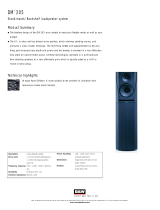 Bowers & Wilkins DM305 User manual
Bowers & Wilkins DM305 User manual
-
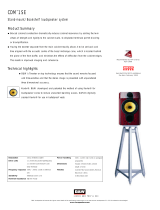 Bowers & Wilkins 1 SE User manual
Bowers & Wilkins 1 SE User manual
-
Wharfedale EVO20 User manual
-
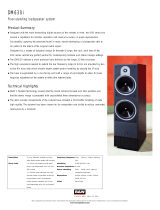 Bowers & Wilkins DM630i User manual
Bowers & Wilkins DM630i User manual
-
B&C Speakers 15 PE 40 User manual
-
Wharfedale 10.4 User manual
-
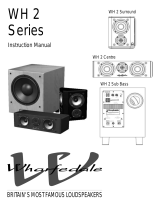 Wharfedale Pro WH 2 Series User manual
Wharfedale Pro WH 2 Series User manual
-
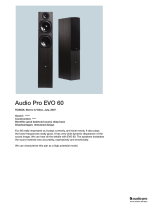 Audio Pro Evo Series Evo 60 Features
Audio Pro Evo Series Evo 60 Features
-
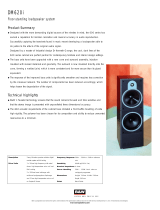 Bowers & Wilkins DM620i User manual
Bowers & Wilkins DM620i User manual




















